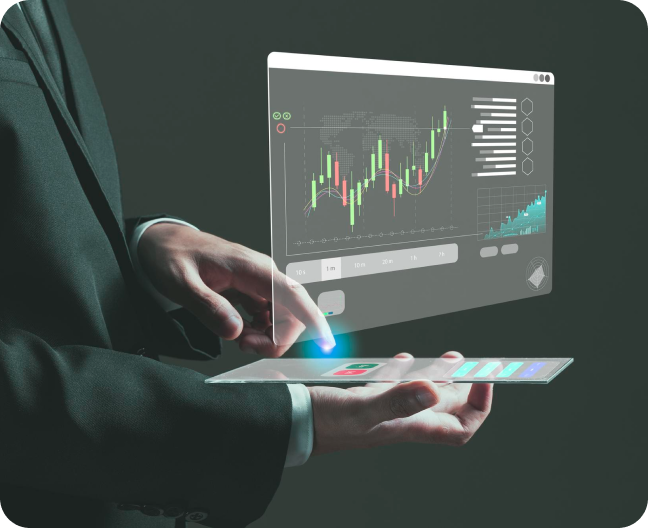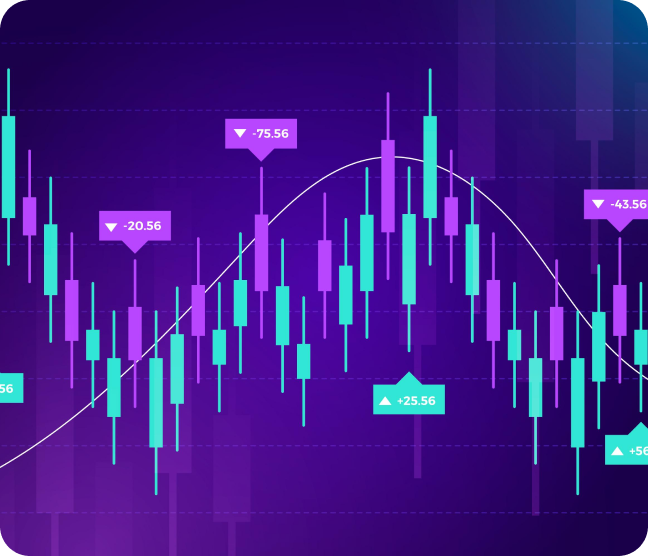


Market analysis helps crypto day traders make decisions in the fast-paced world of trading, and comprises technical, fundamental, and quantitative analysis
Algorithmic trading, a form of quantitative analysis, can execute trades at speeds and frequencies not possible for a human trader.
Crypto day traders should educate themselves on the most common and impactful market analysis techniques and practice using each
How do crypto day traders use market analysis to help them make profitable trades? And what types of market analysis are there? We’ve got you covered in this in-depth article.
Market analysis in crypto day trading encompasses a range of analytical techniques used to evaluate and interpret various market data to enable traders to make informed trading decisions. Effective market analysis is essential for crypto day traders as it provides valuable insights into market trends and price movements, helping them execute trades more strategically.
Traders use the insights gleaned from high-level techniques including technical analysis, fundamental analysis, trend-watching, quantitative analysis, and more, to anticipate future price movements, identify patterns, manage risk, and maximize profits. By leveraging these analytical tools, crypto day traders can better understand market sentiment and predict short-term price fluctuations, which are critical for executing multiple trades within the same trading day.
Technical analysis involves studying price charts and using technical indicators such as moving averages and the relative strength index (RSI) to identify overbought or oversold conditions. This helps traders pinpoint entry and exit points for their trades, enhancing their ability to capitalize on small price movements and avoid significant losses. Chart patterns are another crucial aspect of technical analysis, as they reveal historical price trends that can forecast future price movements.
Fundamental analysis, on the other hand, focuses on the underlying factors affecting the cryptocurrency market, such as technological developments, regulatory news, and market dynamics. This type of analysis helps traders understand the broader market conditions and long-term trends, allowing them to make more informed decisions about their trading strategies.
Risk management is another vital component of market analysis in crypto day trading. Robust risk management practices, including portfolio diversification and setting stop-loss orders, help traders mitigate potential losses and protect their investments in a volatile crypto market. By combining risk management techniques with thorough market analysis, traders can navigate the high volatility of the crypto market more effectively and achieve successful day trading outcomes.
Let’s take a closer look at the how’s and why’s of market analysis in crypto day trading. Whether you’re analyzing market conditions to understand high volatility periods or employing technical analysis tools to forecast future price movements, mastering these analytical techniques is crucial for successful crypto day trading.
Technical analysis is one of the principal tools used by day traders to inform their trading decisions – in crypto as in the tradfi world. The primary techniques used in technical analysis include:
Head and Shoulders: One of the simplest chart patterns to identify, the head and shoulders pattern consists of three peaks, with a higher peak (the head) perched between two lower peaks (the shoulders).
The head and shoulders chart pattern typically follows a market peak, and indicates a trend reversal from bullish to bearish. Observe recent cryptocurrency bull market peaks for strong examples of this.

Triangles: Triangle patterns are used to identify the continuation or reversal of a trend. There are three types of triangle chart patterns: ascending triangles, descending triangles, and symmetrical triangles.
Ascending triangles are a bullish signal characterized by nearly identical highs coupled with consistently higher lows, indicating an imminent breakout.
Descending triangles are like ascending triangles but upside down, where lower highs coupled with nearly identical lows indicate that a price collapse may be just around the corner.
Symmetrical triangle patterns, meanwhile, show neither strong bullish nor bearish signals. Rather, they suggest a brief pause in market movements as bulls and bears reach a temporary equilibrium. A symmetrical triangle can also signal imminent breakouts or market drops depending on the market conditions that preceded it.
Double Tops/Bottoms: Double tops and bottoms are strong reversal patterns, indicated by either two consecutive peaks, or two consecutive bottoms.
A double top is shaped like the letter ‘M’ and typically signals an imminent downturn. A double bottom is shaped like a ‘W’ and typically signals that an upturn is due.
Moving Averages (MA): Moving Average calculates the median price of a given asset over a specific period of time, helping to smooth out price data and identify trends.
Relative Strength Index (RSI): RSI is an oscillator that measures the speed and change of price movements. RSI values above 70 indicate overbought conditions, while values below 30 suggest oversold conditions.
MACD (Moving Average Convergence Divergence): Shows the relationship between the two moving averages of an asset’s price, and is used to identify potential buy and sell signals.
Bollinger Bands: Bollinger bands track the moving average of a given asset, as well as two standard deviations above and below that average. Traders use Bollinger bands to aid them in identifying overbought or oversold conditions.
Fundamental analysis is a critical approach in crypto day trading, leveraging a wealth of simple and complex data points to assess the intrinsic value of crypto assets and predict future price movements. This type of analysis is vital for informed trading decisions, helping traders understand the underlying factors that drive market trends and price fluctuations. By examining on-chain metrics and utilizing quantitative analysis techniques, traders can gain valuable insights into the cryptocurrency market and develop effective trading strategies.
Hash Rate: Hash rate is a fundamental metric in the cryptocurrency market, representing the total computational power used by miners to mine a specific crypto asset. A higher hash rate indicates robust security for the associated blockchain and signals miner confidence. Major changes in hash rate often precede trend reversals or significant shifts in trade volume.
For instance, a sudden increase in hash rate can suggest an upcoming bullish trend, while a decrease might indicate bearish market sentiment. Understanding hash rate trends allows crypto day traders to forecast future price movements and make strategic decisions regarding when to hold or sell their coins, ultimately contributing to successful day trading outcomes.

Transaction Volume: Transaction volume measures the total value of trades executed on a particular crypto asset within a given timeframe. This metric is crucial for identifying market sentiment and the level of interest in a specific asset. Lower transaction volumes can indicate a lack of interest or market activity, signaling potential price stagnation or decline.
Conversely, higher transaction volumes often reflect growing interest and increased market activity, suggesting a potential price surge. By analyzing transaction volumes, traders can better understand market conditions and anticipate short term price fluctuations, enhancing their ability to execute profitable trades.
Active Addresses: Active addresses refer to the number of unique addresses participating in transactions on a cryptocurrency’s blockchain. This metric provides insights into the level of usage and adoption of the underlying blockchain network.
A higher number of active addresses indicates greater network activity and user engagement, which can be a positive indicator of the asset’s potential for growth. Monitoring active addresses helps traders gauge market dynamics and predict future price movements, aiding in the formulation of effective trading strategies.
Algorithmic Trading: Algorithmic trading involves using computer algorithms to execute trades based on predefined criteria. This advanced technique allows for the execution of trades at speeds and frequencies that are not possible for human traders.
Algorithmic trading can take advantage of rapid price movements and market volatility, ensuring timely entry and exit points for trades. By employing algorithmic trading, crypto day traders can optimize their trading strategy and improve their chances of successful day trading.


Backtesting Strategies: Backtesting involves testing trading strategies against historical data to evaluate their effectiveness before applying them to live market conditions. This process allows traders to simulate how their strategies would perform under specific market scenarios, providing valuable insights into their potential success.
By backtesting strategies, traders can refine their approaches, identify potential weaknesses, and increase their confidence in executing trades. This practice is essential for developing robust risk management techniques and achieving consistent profitable trades.
Statistical Arbitrage: Statistical arbitrage uses statistical models to identify and exploit price differences between various assets. This technique involves analyzing historical price data to uncover patterns and correlations that can be leveraged for profitable trades.
By executing trades based on statistical models, traders can capitalize on price discrepancies and achieve significant returns. Statistical arbitrage is particularly effective in the volatile crypto market, where price movements can be unpredictable and rapid.

Fundamental analysis, with its focus on on-chain metrics and quantitative techniques, provides crypto day traders with a comprehensive understanding of the cryptocurrency market. By leveraging these tools, traders can predict future price movements, develop informed trading strategies, and manage risk effectively.
Whether it’s analyzing hash rates to gauge miner confidence, monitoring transaction volumes to assess market interest, or using algorithmic trading for rapid execution, fundamental analysis is an indispensable part of successful crypto day trading. The continuous learning and adaptation of these methods are crucial for staying ahead in the dynamic world of cryptocurrency trading.
Market analysis in crypto day trading is an indispensable tool for deciphering the vast and continuous data stream generated by the cryptocurrency market. This analysis is essential for formulating robust trading strategies that exploit market inefficiencies and capitalize on opportunities that less analytical traders might overlook.
To achieve successful day trading, traders must utilize various market analysis techniques, including technical analysis, fundamental analysis, and quantitative analysis, to make informed trading decisions and execute profitable trades.
Technical Analysis: Technical analysis is pivotal in understanding market trends, price movements, and market sentiment. It encompasses a range of patterns, indicators, and oscillators that help traders interpret disparate data points.

Chart patterns like head and shoulders, triangles, and double tops/bottoms provide visual cues about potential trend reversals or continuations. Indicators such as moving averages, relative strength index (RSI), and Bollinger Bands offer insights into market conditions, helping traders predict future price movements. By mastering technical analysis, traders can identify overbought or oversold conditions, forecast price fluctuations, and make informed trading decisions.
Fundamental Analysis: Fundamental analysis involves evaluating the underlying factors that drive the cryptocurrency market, offering simple yet powerful data points. Key metrics include hash rate, transaction volume, and active addresses, which provide insights into the security, activity, and interest in a given blockchain network.
For instance, a high hash rate indicates strong miner confidence and network security, while increasing transaction volumes and active addresses signal growing interest and usage. Fundamental analysis helps traders understand market dynamics and sentiment, enabling them to anticipate short term price movements and develop effective trading strategies.

Quantitative Analysis: Quantitative analysis leverages computer algorithms to generate and execute trading strategies based on predefined criteria. Techniques such as algorithmic trading, backtesting, and statistical arbitrage are central to this approach.
Algorithmic trading allows for rapid execution of multiple trades, capitalizing on rapid price movements and market volatility. Backtesting involves testing trading strategies against historical data, ensuring their effectiveness in various market conditions. Statistical arbitrage exploits price discrepancies between different assets, providing opportunities for profitable trades. By incorporating quantitative analysis, traders can enhance their trading strategy, optimize risk management, and achieve successful day trading outcomes.

To excel in crypto day trading, traders must continually educate themselves on the most common and effective market analysis techniques. This continuous learning process is crucial for staying ahead in the dynamic and volatile crypto market. By practicing and refining their skills in technical analysis, fundamental analysis, and quantitative analysis, traders can expand their professional repertoire and improve their ability to predict future price movements, execute trades, and manage risk effectively.
Successful crypto day trading relies on a thorough understanding of market trends, price movements, and market conditions. Utilizing a combination of technical analysis tools, fundamental analysis metrics, and quantitative techniques allows traders to navigate the complexities of the cryptocurrency market with confidence. Whether it’s identifying patterns in price charts, analyzing on-chain data, or employing algorithmic trading strategies, a comprehensive approach to market analysis is essential for achieving consistent, profitable trades.
In conclusion, mastering market analysis in crypto day trading is a continuous journey that involves leveraging various analytical techniques to make informed trading decisions. By understanding and applying technical, fundamental, and quantitative analysis, traders can exploit market opportunities, manage risk, and achieve successful day trading. The dynamic nature of the cryptocurrency market demands a proactive and analytical approach, ensuring traders remain adaptable and well-equipped to navigate the ever-evolving landscape of digital assets.